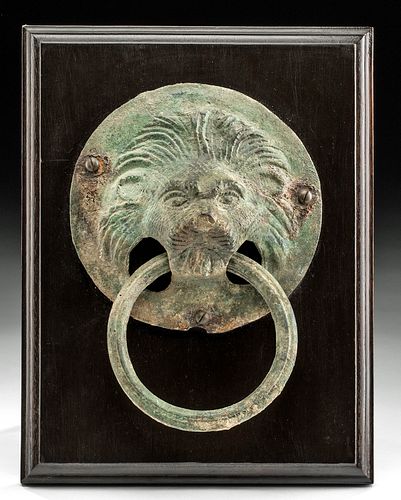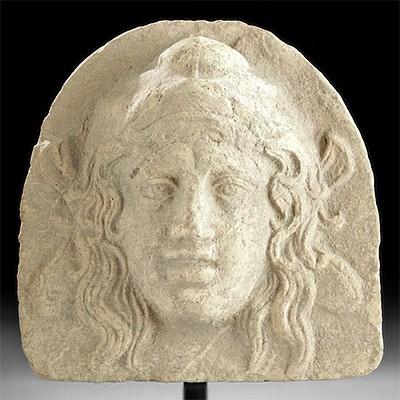Roman Bronze Lion Head Handle w/ Ring
Lot 71a
About Seller
Artemis Fine Arts
686 S Taylor Ave, Ste 106
Louisville, CO 80027
United States
Selling antiquities, ancient and ethnographic art online since 1993, Artemis Gallery specializes in Classical Antiquities (Egyptian, Greek, Roman, Near Eastern), Asian, Pre-Columbian, African / Tribal / Oceanographic art. Our extensive inventory includes pottery, stone, metal, wood, glass and textil...Read more
Categories
Estimate:
$1,800 - $2,500
Absentee vs Live bid
Two ways to bid:
- Leave a max absentee bid and the platform will bid on your behalf up to your maximum bid during the live auction.
- Bid live during the auction and your bids will be submitted real-time to the auctioneer.
Bid Increments
| Price | Bid Increment |
|---|---|
| $0 | $25 |
| $300 | $50 |
| $1,000 | $100 |
| $2,000 | $250 |
| $5,000 | $500 |
| $10,000 | $1,000 |
| $20,000 | $2,500 |
| $50,000 | $5,000 |
| $100,000 | $10,000 |
| $200,000 | $20,000 |
About Auction
By Artemis Fine Arts
Feb 27, 2020
Set Reminder
2020-02-27 10:00:00
2020-02-27 10:00:00
America/New_York
Bidsquare
Bidsquare : VARIETY SALE | Antiquities & Ethnographic Art
https://www.bidsquare.com/auctions/artemis-gallery/variety-sale-antiquities-ethnographic-art-4920
Around the world & back in time - be amazed at the treasures you will find. Antiquities from Egypt, Greece, Italy and the Near East, Asian, Pre-Columbian, African / Tribal / Oceanic, Native American, Spanish Colonial, Russian Icons, Fine Art, much more! Artemis Fine Arts info@artemisfinearts.com
Around the world & back in time - be amazed at the treasures you will find. Antiquities from Egypt, Greece, Italy and the Near East, Asian, Pre-Columbian, African / Tribal / Oceanic, Native American, Spanish Colonial, Russian Icons, Fine Art, much more! Artemis Fine Arts info@artemisfinearts.com
- Lot Description
Roman, Imperial Period, ca. 2nd to 3rd century CE. An attractive example of a bronze handle cast in high relief with the stylized head of a lion. The feline countenance bears dozens of hammered 'hairs' and presents with almond-shaped eyes beneath heavy lids and furrowed brows, a wide snout, incised whiskers above a gaping mouth, and cupped ears that are nearly hidden amongst the shaggy mane. A pair of large holes flanking the mouth support a fluted cast-bronze ring, and the handle body would have attached to a door or chest via three perforated holes. Thick layers of green and brown patina have formed across the handle and knocker. Mounted to wooden display plaque. Size (handle & knocker): 4.875" W x 6.7" H (12.4 cm x 17 cm); (display plaque): 6.7" W x 8.75" H (17 cm x 22.2 cm)
In the classical world, lions symbolized power, wealth, and might. They were famously featured in many ancient myths, perhaps most famous being that of Hercules (Herakles) slaying the Nemean Lion for his first labor. The fur of the Nemean Lion was believed to be impenetrable to attacks since, according to legend, it was made of gold and its claws were far sharper than any man-made blade and possessed the power to cleanly slice through even the toughest of armor. In the end, however, Hercules defeated the lion by strangling it to death and claimed its pelt as a trophy of the monumental achievement.
Lions were also the preferred iconography for buildings, coins, and statues throughout the ancient world. Notable examples include the Lion Gate to the Citadel of Mycenae, the Terrace of the Lions on the island of Delos, and the lion hunt mosaic from Pella featuring Alexander the Great engaged in a lion hunt. Of course, depictions of lions were also employed by Roman arenas where they would battle other animals, such as tigers and bears.
A stylistically similar example, of a larger size, hammered for $6,600 at Christie's, New York "Antiquities" auction (sale 1679, June 16, 2006, lot 266).
Provenance: ex-private Stephenson collection, Greenwich, Connecticut, USA, acquired in Switzerland around 1980
All items legal to buy/sell under U.S. Statute covering cultural patrimony Code 2600, CHAPTER 14, and are guaranteed to be as described or your money back.
A Certificate of Authenticity will accompany all winning bids.
We ship worldwide and handle all shipping in-house for your convenience.
#153426Fissure to one area of ring with small chips along break line. Minor nicks to handle periphery, with softening to some finer details, light encrustations, and slight bending to overall form. Oxidation from original attachment pins present around peripheral attachment holes. Great green and brown patina throughout. Mounted to display plaque with modern metal screws.Condition
- Shipping Info
-
All shipping is handled in-house for your convenience. Your invoice from Artemis Gallery will include shipping calculation instructions. If in doubt, please inquire BEFORE bidding for estimated shipping costs for individual items.
-
- Buyer's Premium



 EUR
EUR CAD
CAD AUD
AUD GBP
GBP MXN
MXN HKD
HKD CNY
CNY MYR
MYR SEK
SEK SGD
SGD CHF
CHF THB
THB















